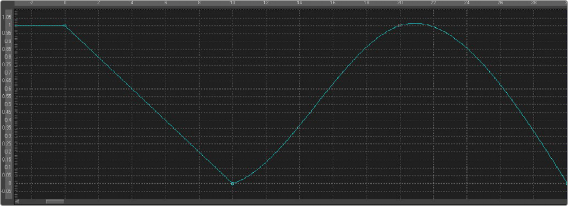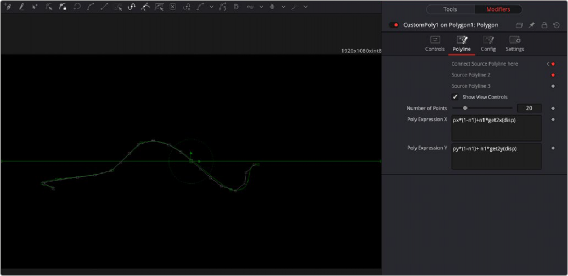
< Previous | Contents | Next >
The Cubic Spline is another animation modifier in Fusion that is normally applied to numerical values rather than point values. It can be applied by right-clicking a numerical control and selecting Modify With > Natural Cubic Spline.
Usage
Being an animation spline, this modifier has no actual Controls tab. However, its effect can be seen and influenced in the Spline Editor.

Cubic Spline Editor
![]()
Custom Poly
The Custom Poly modifier can be added to Polygon masks or paths. Similar in function to the Custom and pCustom tools, existing points can be repositioned in the polyline, or replaced completely with a new set of points. The expressions are evaluated for each point on the output polygon. The modifier can be applied by right-clicking on the “Right-click here for shape animation” text at the bottom of the Polygon controls, and selecting Insert > Custom Poly from the contextual menu.

![]()
Selecting the Custom Poly modifier
Inspector

The Custom Poly Controls tab
Controls Tab
The Custom Poly Controls tab are available once you select the modifiers tab on the Polygon’s inspector. It has a single point input, and number variables to use in animating the expressions. The default is one point and four numbers, but they can be expanded to a maximum of nine.
Additional points and numbers can be added from the Config tab.

The Custom Poly Polyline tab
Polyline Tab
The polyline tab exposes the controls to connect and modify the polyline.
Allows you to connect other polylines to the modifier.
This checkbox toggles the polyline controls visibility in the viewer.
![]()
The number of output points can be set, controlling the amount of custom subdivision of the polyline. A value of zero uses the number of original source points.
Fields for entering the mathematical expressions. For example, px*(1-n1)+n1*get2x(disp) and py*(1-n1)+ n1*get2y(disp).
It uses most of the same expression variables as the Expression modifier below (i.e., n1..n9, p1x..p9x, p1y..p9y, math functions, etc.), and it adds:
— px,py for the current point on the source polygon
— disp for the point’s displacement on the polyline (0.0 is start, 1.0 is end)
— index for the current point’s index (zero-based)
— num for the number of output points
— getx(disp), gety(disp) to get values from anywhere on the polyline
— getx_at(disp, time), gety_at(disp, time) to get values from polylines at other times
— Similarly, get2x/y(), get3x/y(), get2x/y_at(), get3x/y_at() for the second and third source polys